Developing a story from the introduction to your main character’s ordinary world to their eventual victory may feel daunting. What exactly will you fill all those chapters with? Enter the 24 chapter novel outline. Learn more about this detailed plot structure by Derek Murphy that you can use via a convenient template in Plottr.
What is the 24 Chapter Novel Outline?
The 24 Chapter Novel Outline came about when Derek Murphy, author of The Plot Dot, wanted to expand on the eight-point novel template detailed in his book.
This novel outline template is ideal for writing commercial fiction. It includes areas to input four plotlines based on a three-act structure, with 34 scene cards and 25 spaces for beats. Murphy calls it “a guide to plot your first draft or fix your story if you get stuck.”
To come up with this outline template, Murphy first looked at all the many story structures out there, some of which conflict with each other. He used his observations, plus his ideas about what he really wanted, to create a more in-depth story outlining method. The result? The 24 Chapter Novel Outline which holds your hand as it leads you through building the framework of a story.
Who is the 24 Chapter Novel Outline Plot Template For?
The 24 Chapter Novel Outline serves writers who want to produce commercial fiction. It’s excellent if you’ve read books about other plotting structures and have been left either more confused or stressed out at the idea of trying to fit your story idea into more rigid parameters.
If you’re just getting started and you like step-by-step guides, this may be perfect plotting structure for you.
Watch a video guide to the 24 Chapter Novel Outline template by author and Plottr Education Lead, CJ Anaya, and continue reading the written guide below:
Plot Points of the 24 Chapter Outline
Let’s take a closer look at plot points you’ll find in the 24 Chapter Novel Outline plot template
Act 1: Hero and Ordinary World
This act contains six scenes that correspond to chapters.
Scene #1: Really Bad Day
Show your main character in their ordinary world, but on a day when they especially want something – and are unable to get it.
Example: The movie Enola Holmes opens with Enola, the younger sister of Sherlock, riding a bike and speaking directly to the viewer. She says she’s always been close with her mother, who has given her a remarkable education for a girl of her time. But when Enola wakes up on her 16th birthday, she discovers her mother is missing.
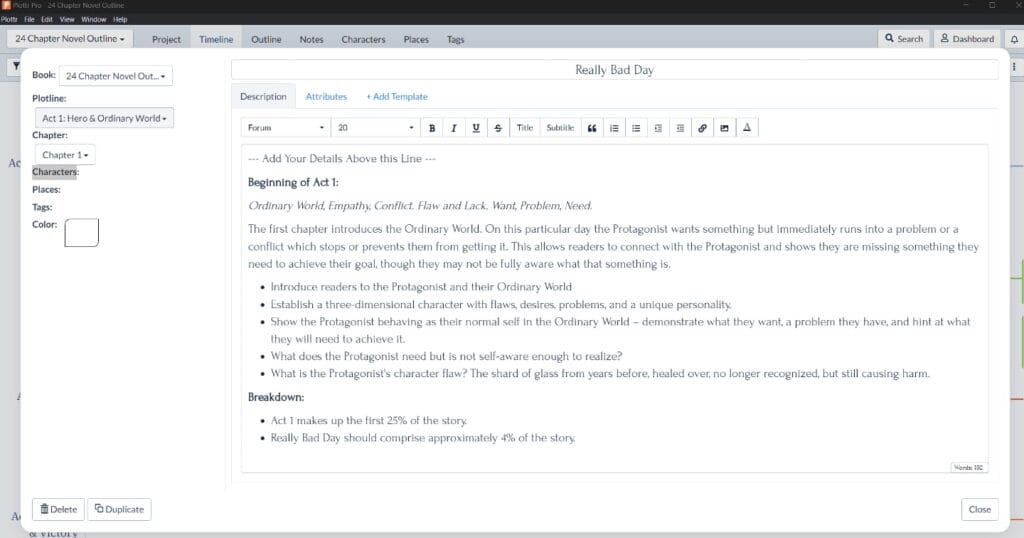
Scene #2: Something Peculiar
In this moment, something strange happens — but the characters dismiss it for some reason.
Example: When Enola awakes to find that her mother isn’t home, she notes that it’s odd her mother left no indication where she went. Nevertheless, she simply waits for her return, believing she’ll come back because she loves Enola.
Scene #3: Grasping at Straws
The character tries to regain control of their ordinary world, but setbacks begin to mount.
Example: When it becomes clear something’s wrong, Enola’s brothers Sherlock and Mycroft arrive as her new guardians. But instead of helping her look for their mother, Mycroft says he’s going to send Enola off to a finishing school. Enola, staring down this unpleasant future, feels as if she’s losing control of her life and independence.
Scene #4: Call to Adventure
Next, something really profound happens that your characters simply can’t ignore. These events cause a major setback, and your protagonist realizes there is no going back to that ordinary world now.
Example: In the film, Enola discovers a secret message from her mother — a lover of ciphers — and runs away from home on a mission to find her mother.
Scene #5: Head in Sand
The protagonist initially tries to refuse their call to adventure. However, it ends up being impossible to ignore.
Example: Enola boards a train — dressed as a boy, to avoid scrutiny — and soon meets the young and handsome Viscount Tewkesbury, who has also run away from home and stowed away on the train. There is a man in a bowler hat (soon identified as Linthorn) looking for him, and Enola tells Tewkesbury to get out of her carriage so that she’s not discovered. She wants nothing to do with him.
Scene #6: Pull Out Rug
Despite their continued efforts to restore life to their ordinary world, something happens that forces your protagonist to accept the call to adventure.
Example: Tewkesbury leaves but immediately comes back. Enola leaves the carriage instead, but despite her inner debate she returns and sees Linthorn trying to kill Tewkesbury. She can’t turn away and decides to help him escape.
Act 2A: Exploring New World
The second section of the 24 Chapter Novel outline template contains six scenes that help you map out chapters seven to twelve.
Scene #7: Enemies & Allies
The protagonist explores the New World, meets other characters who will reveal themselves to be either allies or enemies, and they begin to figure out their role in this New World.
Example: After jumping from the train, Enola and Tewkesbury make their way to London, where Enola insists they part ways so she can continue her search for her mother. She meets her mother’s mysterious friend Edith, Tewkesbury’s family, Inspector Lestrade, and others as this part of the story unfolds.
Scene #8: Games & Trials
Here, your main character struggles to belong and experiences frustration and doubt—as well as trials and challenges—while embarking on the early, frustrating stages of their journey.
Example: Enola uses the money her mother left her to navigate fitting into London with proper attire, finds lodging, and follows clues to discover places her mother visited.
She soon learns her mother may be involved in something dangerous. But when Enola is attacked by Linthorn, her plan changes to saving Tewkesbury first. In the process of helping Tewkesbury escape capture, she is caught by Mycroft and sent to Miss Harrison’s Finishing School, where she is absolutely miserable.
Scene #9: Earning Respect
A small victory proves the main character is capable and creates a begrudging acceptance by the other characters.
Example: Sherlock visits Enola at her boarding school and gives her clues about how to solve the Tewkesbury case. It’s obvious he admires how far she’d progressed on the case before Mycroft caught her. Not long after, Tewkesbury has himself smuggled into the school, and together they escape.
Scene #10: Forces of Evil
Here, the stakes are raised drastically and your antagonist is revealed.
Example: Enola tells Tewkesbury that his uncle is behind the attempts on his life because he’ll inherit the family estate if Tewkesbury dies. She suspects the uncle killed Tewkesbury’s father as well.
Scene #11: Problem Revealed
Feeling overwhelmed and not given proper information, your protagonist demands answers from their allies. It’s highly likely they won’t like what they learn.
Example: Suspecting there is more to the story than previously thought, Enola asks Tewkesbury how he will vote on a reform/women’s suffrage bill if he takes his seat in the House of Lords.
Scene #12: Truth and Ultimatum
The main character learns information that changes their entire worldview—and responds accordingly.
Example: In Enola Holmes, Tewkesbury tells Enola he’ll vote on a suffrage bill the same way his father would have. Enola also learns that giving women the right to vote is exactly what her mother has been working on in secret — evidently with violent intent, based on the bombs Enola has found.
Act 2B: Bad Guys Close In
The third plotline in the 24 Chapter Novel Outline template runs from chapters 13 to 18.
Scene #13: Mirror Stage
This scene is where the protagonist goes from victim to warrior, developing their internal motivation from reluctant to deliberate and moving forward in a more meaningful way.
Example: The defeated Enola who submitted to being at Miss Harrison’s school is no more. She becomes determined to solve the case and protect Tewkesbury in the process.
Scene #14: Plan of Attack
Now all in, the protagonist formulates a plan of attack against the antagonist.
Example: Enola tells Tewkesbury he has to confront his family, so the two of them steal an automobile from the boarding school’s headmistress and head to Tewkesbury’s home.
Scene #15: Crucial Role
After the plan of attack has been made, the protagonist’s newfound trust of other characters becomes clear when they are given a crucial role to play.
Example: Enola drives them to Basilwether Hall and accompanies Tewkesbury inside (she knows martial arts, after all), only to find it dark with no servants around. Enola says his family must know they are there for a confrontation.
Scene #16: Direct Conflict
The plan of attack is executed and the protagonist comes into direct conflict with the antagonist’s forces.
Example: Enola realizes she has underestimated the situation when Linthorn starts shooting at her and Tewkesbury, and things look very bad for them.
Scene #17: Surprise Failure
The plan goes horribly wrong, resulting in some potentially devastating consequences—think major injury, or even the death of characters important to the protagonist.
Example: Enola is hit in the head by the butt of Linthorn’s gun, and Tewkesbury is shot in the chest, making Enola fear he is dead.
Scene #18: Shocking Revelation
The antagonist’s true identity and full plan are revealed. The protagonist experiences guilt and anger.
Example: The person who wants Tewkesbury dead isn’t his uncle after all. It’s his grandmother, who doesn’t want times to change. So she got rid of her own son and has also tried to kill her grandson to prevent both of them from voting for the reform bill.
Act 3: Defeat and Victory
This act, the fourth plotline in Plottr’s template, covers the final chapters, 19 to 24, with an optional Chapter 25.
Scene #19: Giving Up
The protagonist loses their confidence and essentially gives up after losing the battle with the antagonist, whom they have clearly underestimated.
Example: Enola crawls over to Tewkesbury’s body and cries.
Scene #20: Pep Talk
The protagonist no longer has as much self-belief as before, and is in need of encouragement from an ally. The protagonist may also begin to confront their fatal flaw.
Example: Tewkesbury grasps Enola’s hand, and he reveals that he’d used a piece of a nearby suit of armor to protect himself from the gunshot.
Scene #21: Seizing the Sword
A deliberate choice to continue is made, even if there is a slim chance of success. The protagonist gathers materials and allies to prepare for the final, epic battle with the antagonist and their forces.
Example: Her side mission of saving Tewkesbury complete, Enola is back to looking for her mother when she spots a response to the cipher she put in the newspaper. But it’s signed “Mother,” which she knows means it wasn’t sent by her mother at all.
Scene #22: Ultimate Defeat
This is the “all is lost!” or the black moment of the story where the villain/antagonist appears to have won. The protagonist thinks she understands her fatal flaw but actually doesn’t, and that hubris leads to her defeat.
Example: The cipher was sent by Mycroft, in an attempt to recapture Enola. She disguises herself as a boy and escapes his notice at the rendezvous point mentioned in the cipher. Defeated that she still hasn’t found her mother and may never find her, Enola returns to her rented room.
Scene #23: Unexpected Victory
The protagonist’s secret weapon or ability, deep resolve, and new understanding of himself allows him to defeat the antagonist.
Example: Her mother is waiting for her in Enola’s room. She finds out that by saving Tewkesbury, allowing him to vote in favor of the suffrage bill and ensuring its passage, she has prevented the terrorist act her mother and other suffragettes were planning.
Scene #24: Bittersweet Reflection
The protagonist has won the battle, and it is now time for a joyful celebration or bittersweet reflection. If the book is part of a series, the defeat of the antagonist may only be temporary.
Example: Enola tells the viewer that she is a detective, a finder of lost souls, and her life is her own.
Death of Self (Optional)
This optional chapter can be used to fill in plot holes or show that the protagonist has either come full circle, or is a new person who is going to be forging a new path from now on.
You can also hint of future challenges, particularly if this book is part of a series with a recurring protagonist.
Example: Viewers get the feeling this was only the first of many cases Enola Holmes will solve.
If you’re looking for further instructions and examples, Derek Murphy discusses this system of plotting here.
How Do You Use the 24 Chapter Novel Outline Template in Plottr?
Ready to create your own four-part outline? First, make sure you have an active Plottr membership plan or get started with a free 30-day Plottr trial.
Then, follow these simple steps to get going:
- Step 1: In the Files tab of the Plottr Dashboard, click Create From Template
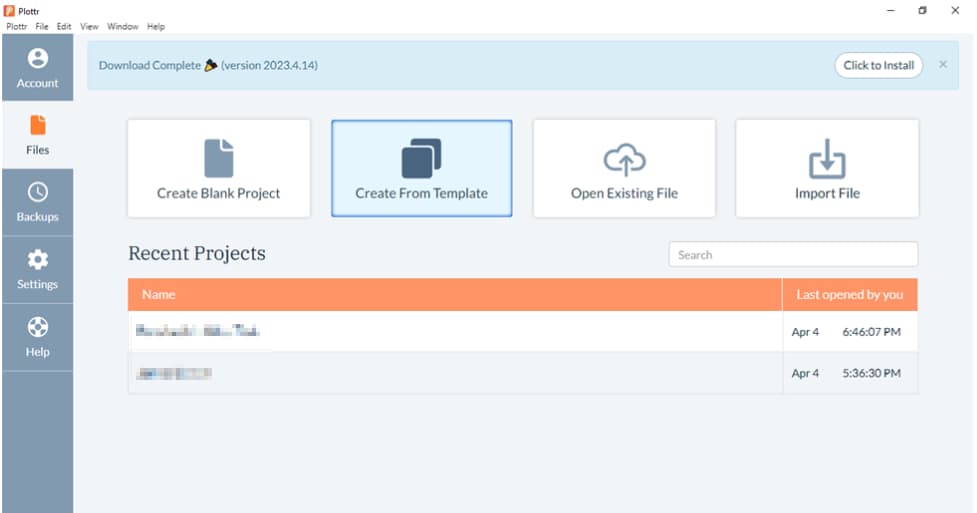
- Step 2: From the list of Plottr templates, select 24 Chapter Novel Outline, then click Create New Project
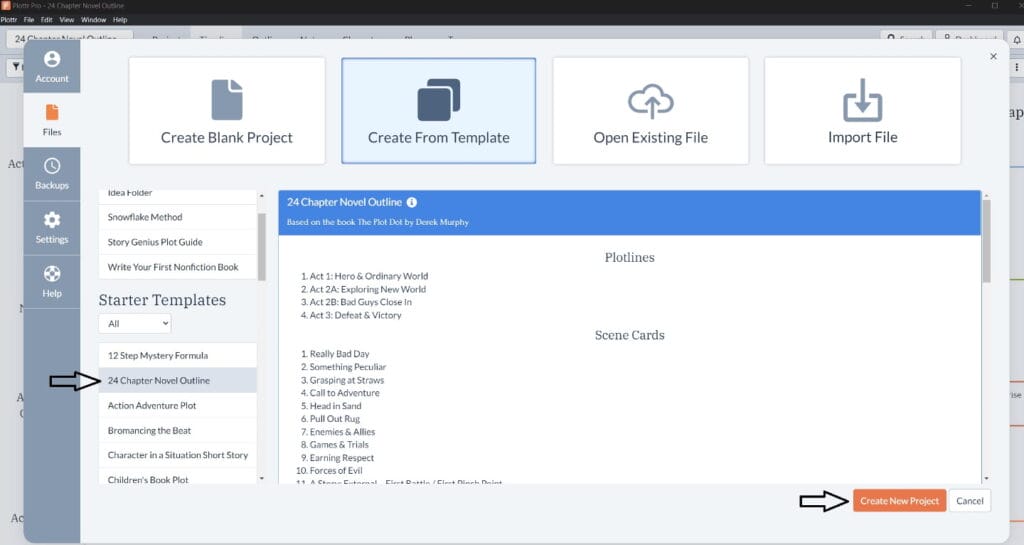
- Step 3: Give your project a name so you can find it easily under recent projects. It will open in timeline view
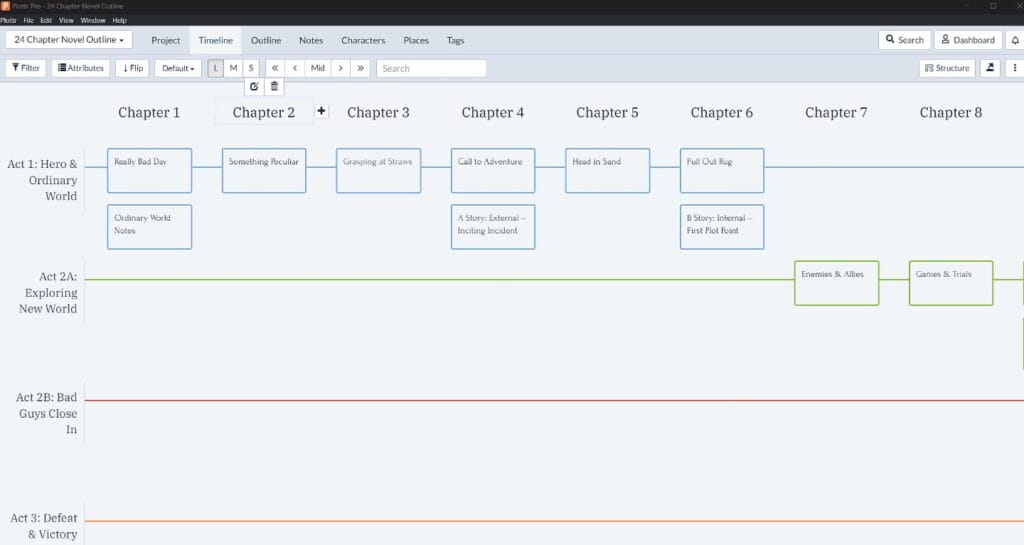
- Step 4: Click on any of the chapters’ scene cards to open them up and begin adding your ideas. You can keep or delete the guideline text
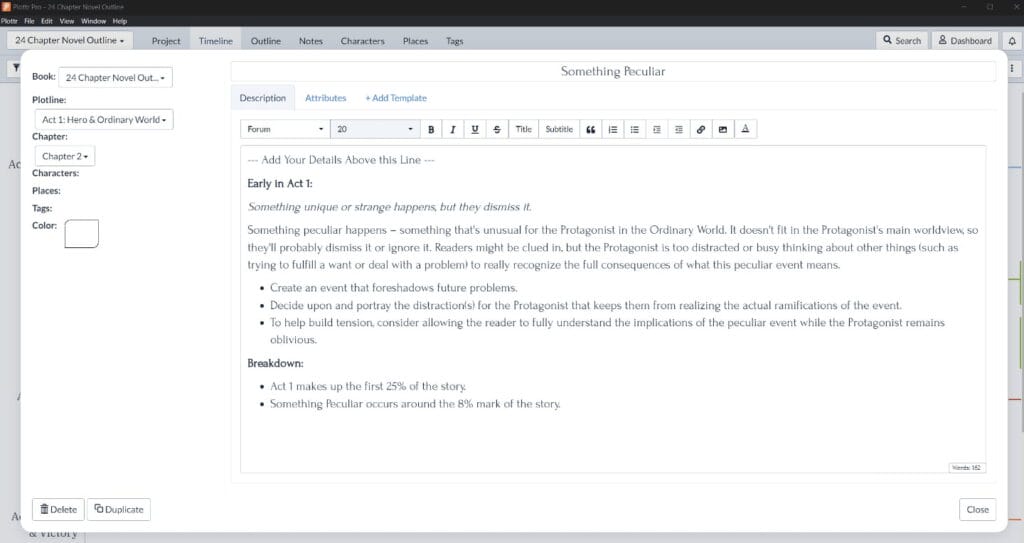
Plot templates in Plottr work together well, so try these others if you’d like to create additional plotlines such as subplots:
Go on an Adventure
If you’re ready to tackle mapping out your story, try the 24 Chapter Novel Outline template in Plottr. Don’t have Plottr yet? Start a free trial today and get planning with countless templates!









Comments